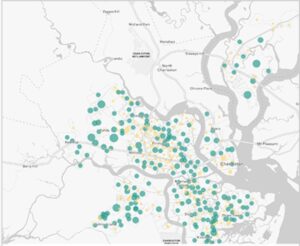
Hey everyone, I’m Aninditha Nair(I know it is hard to pronounce so “Anin” works just fine) I am a freshman, majoring in Computer Science and Data Analytics and minoring in Environmental Science and Dance. I’m from a small town near Mumbai, India. Currently, I’m involved in the Campus Programming Board and Horizons International. I want to learn GIS because I really want to understand new facets of environmental science and technology.
Reading Schuurman’s chapter one gave me an insight into GIS and helped me connect it to my specific interests. I found it interesting that GIS is used so extensively around the world, especially for organ donations and epidemiology, which I had no idea of. It is also amazing how different people in different countries implemented GIS in one form or another and how it is called an inevitable development. I liked the mention of spatial data analysis because, during ENVS110, my TPG proposal project made use of spatial data to analyze marginalized communities for flood risk and management.
I had a misconception that GIS was all about geography and cartography, and even though those constitute a lot of it, it was nice to see so much computation and technology being involved in the process. I also think it is interesting to notice that GIS now often refers to Geographic Information Science and not Geographic Information Systems. I didn’t know that GIS had two different types of identities. The black box identity seemed intriguing to me, and how researchers were more curious about what underlies the technology than the application of existing technology.
Reading the chapter also made me realize the similarities between GIS and my data analytics class. GIS allows the visualization of spatial data and also provides a means of utilizing fuzzy data. Similarly, for Data Analytics, we accumulate data and visualize it to analyze further and find better solutions. I’m also amazed to find out that India is at the forefront of e-governance technologies and implementation using GIS(I swear I’ve lived in India all along, I’m just dumb). In the end, the chapter summarized every single chapter in the book in a succinct manner. I feel more comfortable and prepared with the course now that I have a small gist of what the entire book is going to be about.
For the GIS applications, I looked at the application for Racial Equity. I specifically looked at ESRI GIS HUB and their ways of addressing racial inequalities. They go through a four-level-process: Engage communities →Map and analyze inequities →Operationalize best practices →Manage performance. They use maps and spatial analysis to reveal and understand inequities in experiences and outcomes within communities. Another application I found interesting was the application for Climate Models. I was unaware of the fact that GIS and Climate Modelling could be so intertwined. A GIS-based analysis of the tornado in Joplin, Missouri, in 2011 shows how combining weather and climate information can be useful when it comes to answering questions like, “How many miles of roadways were in the tornado path?”, and “Which roads likely need to have signs replaced or debris cleared?”

Sources:
https://gis-for-racialequity.hub.arcgis.com/
https://www.esri.com/about/newsroom/arcuser/mapping-and-modeling-weather-and-climate-with-gis/
GIS (science and systems) are a great unknown to most people. they dont’ think about using google maps every day, or how the UPS truck is being routed, or waste water managed, or fresh water delivered to homes in pipes, or why all of a sudden Delaware got a Canes and a few Chipotles. its running our lives and most of us have no clue.